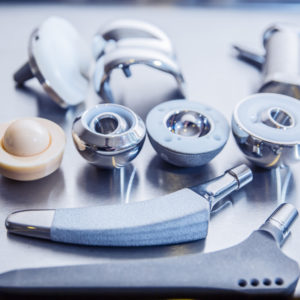Newer Knee, Hip Replacement Implants May Not Provide Added Benefit: Study

New research suggests that recent hip and knee implant innovations often provide little benefit for patients, and in some cases may actually increase the risk of serious health or safety problems.
Over the last few years, a number of major artificial knee and hip replacement recalls have been issued involving new generation designs, resulting in thousands of product liability lawsuits and questions over whether the products were sufficiently tested before they were introduced.
In a study published last week in the British Medical Journal, researchers suggested that the medical device industry appears to be putting out poor products, indicating that they could find no convincing evidence that new hip and knee implants are any better than devices that have been on the market for years. The team called for new standards for the testing and approval of joint implants.

Learn More About
Lawsuits are being reviewed for several different dangerous and defective hip replacement systems.
Learn More About this Lawsuit See If You Qualify For CompensationUsing data from the FDA, the researchers looked at clinical trials and studies that involved 15,384 implants used in 13,164 patients. They focused on five specific innovations that have recently hit the joint replacement surgery industry.
Researchers report that they could find no improvement in device survival, and in three of the five cases, patients suffered more revision surgery to deal with failed or malfunctioning devices.
“We did not find convincing high quality evidence supporting the use of five substantial, well known, and already implemented device innovations in orthopedics,” the researchers concluded. “Moreover, existing devices may be safer to use in total hip or knee replacement, improved regulation and professional society oversight are necessary to prevent patients from being further exposed to these and future innovations introduced without proper evidence of improved clinical efficacy and safety.”
Metal-on-Metal Hip Replacements
The most well-known debacle involving new devices in recent years has been metal-on-metal hip replacement systems. Usually made of chromium and cobalt, these hip implants used metal ball-and-socket designs that were meant to increase durability for younger and more active users.
While most hip replacements are expected to last 10 to 15 years, reports of problems with metal-on-metal hip implants began to surface at alarming rates, often resulting in catastrophic failure of the device and the need to revise the artificial hip.
The problems gained widespread media attention in August 2010, when a DePuy ASR recall was issued due to high failure rates. That led to the medical community taking a second look at the metal-on-metal design and finding that the devices were shedding metal particles into the tissue and blood of the recipients, leading to tumors, necrosis and metal blood poisoning.
The Johnson & Johnson subsidiary recently agreed to pay $2.4 billion to settle more than 12,000 DePuy ASR hip lawsuits. However, the company still faces massive litigation over DePuy Pinnacle hip system lawsuits, which is another metal-on-metal hip implant that has been linked to similar problems. Other metal hip lawsuits have been filed against other manufacturers, including Biomet, Wright Medical and others.
Many experts have suggested that the only reason patients and doctors in the United States became aware of the complications with the DePuy ASR hips were due to European and Australian joint replacement registries. There were no such registries in the U.S. at the time, but a American Joint Replacement Registry (AJRR) was launched later that year.
Modular Hip Implants
Similar problems have developed with new implant designs that involve a modular femoral component, with two pieces that fit inside each other to allow surgeons to adjust the size of the piece to match the patient anatomy.
One of the first such designs was the Wright Pro Femur Total Hip System, which has been linked to problems where the femoral neck stem may fracture and fail.
In July 2012, a Stryker Rejuvenate hip recall was issued for similar modular hip designs, after the manufacturer acknowledged that the components were prone to fret, corrode and fail as the components rub against each other during normal use.
The recall came only two years after the design was introduced, and has resulted in thousands of Stryker Rejuvenate lawsuits alleging that the manufacturer failed to adequately research the design. An estimated 20,000 of the implants were sold before the problems were discovered, according to allegations raised in the complaints.
Knee Replacement Problems
The issues are not isolated only to hip implants, as several new generation knee replacements have also been linked to problems in recent years, resulting in lawsuits alleging that the manufacturers introduced defective and potentially unsafe designs.
Currently, more than 1,000 patients who previously received Zimmer NexGen knee implants are nowpursuing product liability lawsuits, alleging that certain designs are unreasonably dangerous.
The Zimmer NexGen system was first introduced in 1995, with most components later approved without extensive trials or FDA investigation into their safety through the 510K fast-track approval program, which only requires that devices be “substantially equivalent” to medical devices already on the market to obtain marketing approval.
All of the plaintiffs now claim that they experienced problems with certain Zimmer knee replacements, which were allegedly caused by design problems and Zimmer’s failure to provide accurate information about the risks associated with the implant.
Cutting Guide Technology
Another recent innovation that has been linked to reports of problems was a custom-designed cutting guide introduced for use with the Stryker Triathlon knee implant. The manufacturer marketed the use of disposable cutting guides generated based on 3D imaging data from an MRO or CT scan, which was used to customize a pre-operative surgical plan for each patient.
In April 2013, a Stryker ShapeMatch recall was issued after it was discovered that the cutting guides provided may not match the specifications entered by the surgeon through a web app, potentially causing the knee replacement to loosen and fail.
Stryker stopped selling the ShapeMatch Cutting Guide in November 2012. A Product Notification was sent to all hospitals and medical providers using the system in January 2013, informing them of the problem and risk mitigation factors. A class 1 recall was issued in April, after Stryker recommended that patients contact their physicians if they are experiencing problems after a knee replacement surgery where the ShapeMatch Cutting Guide was used.
Many surgeons have questioned why the ShapeMatch cutting guide technology was necessary, and questions have been raised in some product liability lawsuits over whether sufficient benefits were ever provided for consumers.
Get more articles like this sent directly to your inbox.
"*" indicates required fields






0 Comments